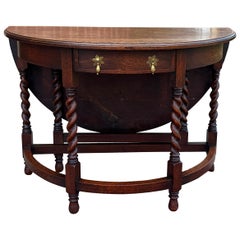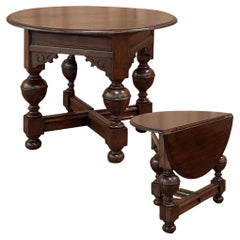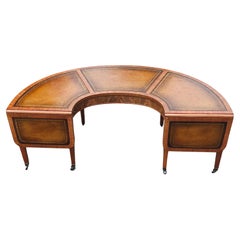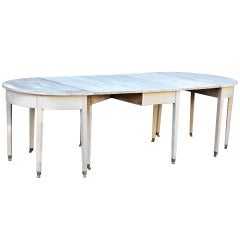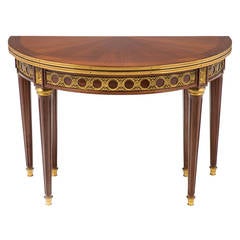Drop Leaf Demilune Table
Antique Early 18th Century Dutch Baroque Drop-leaf and Pembroke Tables
Oak
Vintage 1920s English Edwardian Drop-leaf and Pembroke Tables
Oak
Antique Late 19th Century Dutch Dutch Colonial Console Tables
Oak
Mid-20th Century American Georgian Coffee and Cocktail Tables
Brass
20th Century Danish Mid-Century Modern Dining Room Tables
Wood, Teak
Recent Sales
Antique 18th Century and Earlier English Drop-leaf and Pembroke Tables
Antique Early 1900s French Louis XVI Demi-lune Tables
Brass
20th Century American American Classical Desks and Writing Tables
Brass
Antique 19th Century English Baroque Sofa Tables
Oak
Mid-20th Century American Mid-Century Modern Demi-lune Tables
Fruitwood
20th Century English Regency Serving Tables
Brass
Antique Late 19th Century Swedish Demi-lune Tables
Oak
Antique 18th Century and Earlier Dining Room Tables
Antique 19th Century European Console Tables
Oak
People Also Browsed
Vintage 1930s English Jacobean Drop-leaf and Pembroke Tables
Oak
2010s Belgian Modern Sofas
Linen
2010s Italian Wardrobes and Armoires
Walnut
Vintage 1930s American Federal Coffee and Cocktail Tables
Mahogany
Antique 1870s Dutch Dutch Colonial End Tables
Brass
Drop Leaf Demilune Table For Sale on 1stDibs
How Much is a Drop Leaf Demilune Table?
Finding the Right Tables for You
The right vintage, new or antique tables can help make any space in your home stand out.
Over the years, the variety of tables available to us, as well as our specific needs for said tables, has broadened. Today, with all manner of these must-have furnishings differing in shape, material and style, any dining room table can shine just as brightly as the guests who gather around it.
Remember, when shopping for a dining table, it must fit your dining area, and you need to account for space around the table too — think outside the box, as an oval dining table may work for tighter spaces. Alternatively, if you’ve got the room, a Regency-style dining table can elevate any formal occasion at mealtime.
Innovative furniture makers and designers have also redefined what a table can be. Whether it’s an unconventional Ping-Pong table, a brass side table to display your treasured collectibles or a Louis Vuitton steamer trunk to add an air of nostalgia to your loft, your table can say a lot about you.
The visionary work of French designer Xavier Lavergne, for example, includes tables that draw on the forms of celestial bodies as often as they do aquatic creatures or fossils. Elsewhere, Italian architect Gae Aulenti, who looked to Roman architecture in crafting her stately Jumbo coffee table, created clever glass-topped mobile coffee tables that move on bicycle tires or sculpted wood wheels for Fontana Arte.
Coffee and cocktail tables can serve as a room’s centerpiece with attention-grabbing details and colors. Glass varieties will keep your hardwood flooring and dazzling area rugs on display, while a marble or stone coffee table in a modern interior can showcase your prized art books and decorative objects. A unique vintage desk or writing table can bring sophistication and even a bit of spice to your work life.
No matter your desired form or function, a quality table for your living space is a sound investment. On 1stDibs, browse a collection of vintage, new and antique bedside tables, mid-century end tables and more .
- What is a drop-leaf table?1 Answer1stDibs ExpertSeptember 25, 2019
A drop-leaf table has a fixed section in the center and a hinged section, or leaf, on each side that can be folded down.
- How do I date a drop-leaf table?1 Answer1stDibs ExpertApril 5, 2022To date a drop-leaf table, first look for saw marks. If you see straight ones, your table likely dates back to before the early 19th century. Pieces made after should show curved saw marks. A licensed furniture appraiser can assist you with determining an exact date. Find a range of expertly vetted drop-leaf tables on 1stDibs.
- 1stDibs ExpertMay 5, 2023The first drop-leaf tables emerged during the era of the early 17th century. These first pieces usually feature a gate leg that swings out to support the leaf. Drop-leaf tables with side brackets debuted in the early 19th century. On 1stDibs, shop an assortment of drop-leaf tables.
- How does a drop leaf table work?1 Answer1stDibs ExpertAugust 24, 2021A drop-leaf table features a fixed section and one or more foldable sections. The well-made hinges hold the fixed and foldable sections and allow the leaves to pop up. These sections are anchored with the help of swing-out legs for secure placement. Find antique and vintage drop-leaf tables on 1stDibs.
- 1stDibs ExpertSeptember 28, 2021A drop-leaf table is a type of table that has a fixed portion in the center and foldable portions on either side joined by hinges. These foldable portions can be dropped and closed to save space when the table is not in use. On 1stDibs, find a variety of antique and vintage drop leaf dining tables.
- 1stDibs ExpertFebruary 13, 2023While you can look for markings and other details to try and determine the maker, the best way to identify an antique drop leaf table is to work with a certified appraiser. Trusted online venues and search engines can be helpful when conducting research on a specific collectible, piece of jewelry, art work or other item about which you may have questions, but qualified professionals, such as an antiques dealer or an appraiser at an auction house, have the knowledge and experience needed to make more accurate identifications. Shop a selection of antique, vintage and modern tables on 1stDibs.
- 1stDibs ExpertNovember 20, 2024To tell how old your drop leaf table is, first see if it bears a maker's mark. Looking up this marking using trusted online resources can enable you to identify the maker. From there, you can conduct further research to determine when it was in business and crafting tables like yours. For unmarked tables, it is generally necessary to become familiar with the various styles of drop leaf tables, such as the 17th-century Gateleg table, recognizable by the stretchers that connect its legs, and the 18th-century Pembroke table, which typically has two drawers. However, contemporary reproductions of these types of tables exist, making it difficult to date pieces without training and experience. As a result, you may wish to use the services of a certified appraiser or experienced antique dealer. On 1stDibs, explore an assortment of drop leaf tables.
- 1stDibs ExpertFebruary 17, 2023The difference between a gateleg table and a drop leaf table is the design of the section that you can raise to expand the piece. On a drop leaf table, the extension does not have any lower support. A gateleg table has a leg that swings out to rest beneath the extension. Find a selection of tables from some of the world's best sellers on 1stDibs.
Read More
20 Inviting Dining Rooms Perfectly Arranged for Entertaining
Top interior designers show — and tell — us how to create delectable spaces for hosting dinner parties.
This Alain Delon–Designed Table Is Almost as Handsome as He Was
Fans of the French film star may be surprised to learn that he had a flair for furniture with sleek lines and disco-era flash.
Uchronia’s Plant Stand Gives Pots a Pretty Perch with All the Trimmings
Like other pieces in the firm’s Candy Box collection, the cheerful limited-edition design showcases French craft.
The Ultimate Guide to Types of Tables for the Home
Whether you’re just moving in or ready to give your home a makeover, our guide will give you pointers on tables that are fitting for every room, nook and hallway.
Is Lionel Jadot the Willy Wonka of Upcycled Belgian Design?
From his massive collaborative workshop in a former paper factory, the designer concocts funky furniture from disused materials, as well as luxe hotel interiors like the new Mix Brussels.
Inspired by the Cosmos, Sandra Nunnerley’s Nova Table Has a Futuristic Feel
The designer’s innovative use of an unexpected material gives this console a lift.
This 19th-Century Gilded Desk Displays a Fanciful Kingdom in Marquetry
The stately piece brings both gravitas and whimsy to any work space.
In Guadalajara, These Luscious Side Tables Are Chiseled from Volcanic Rock
Use them as tables or stools, indoors or out.

